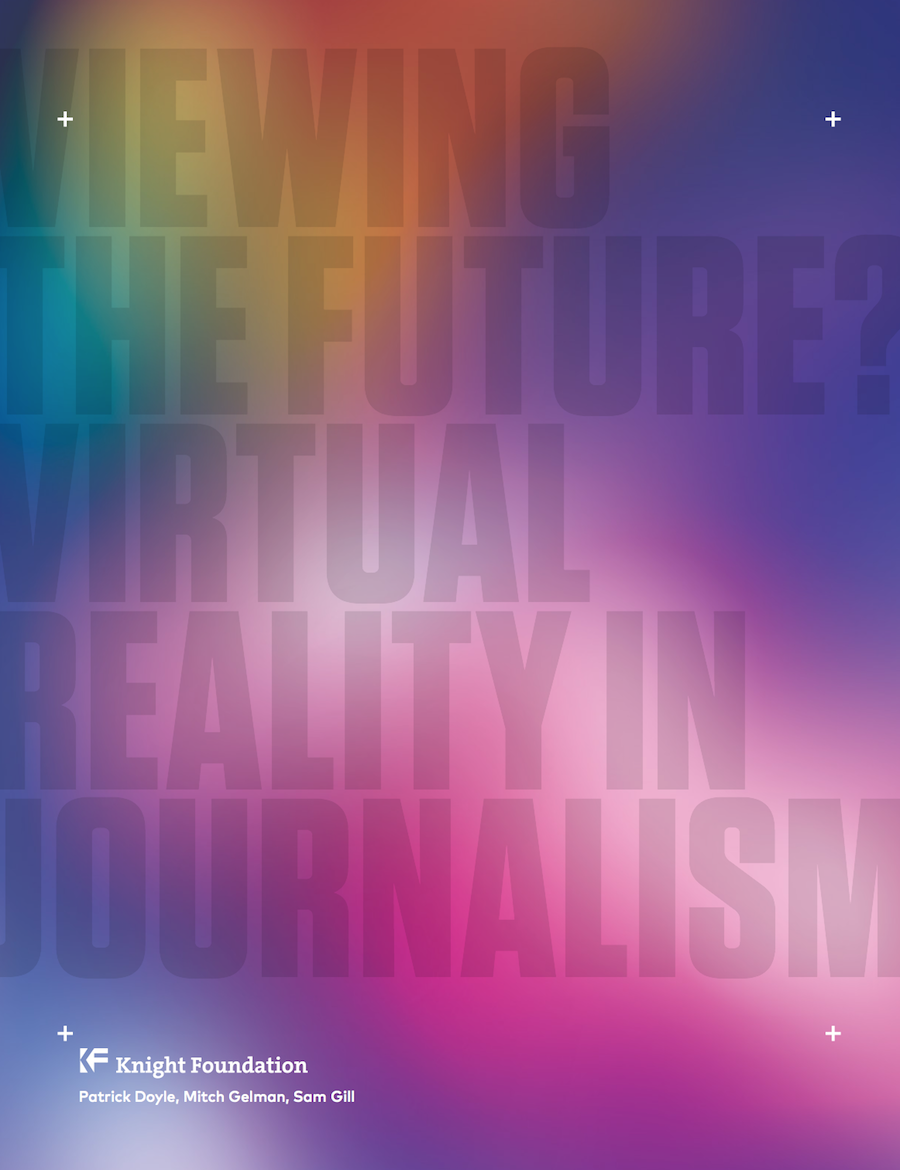AUSTIN, TEXAS — March 13, 2016 — How big a role will virtual reality play in the future of news? This is the topic of a new report, which explores the use of virtual reality as a medium for new, immersive storytelling, providing a view into its potential for growth and the challenges ahead.

REPORT: Viewing the Future? Virtual Reality in Journalism
Viewing the Future? Virtual Reality in Journalism, report by Patrick Doyle, Mitch Gelman and Sam Gill on Medium.com, 3/13/2016
Produced by Knight Foundation in collaboration with the USA TODAY NETWORK, the report chronicles the rise of virtual reality in journalism as a new way to inform and engage audiences. It offers a survey of news organizations, catalogs key projects, provides a review of existing studies and introduces new research in the space. The report establishes 2016 as a make-or-break year for virtual reality in news and asks: Will adoption become widespread? Or will virtual reality journalism succumb to issues such as costs, accessibility, production difficulties and ethical considerations?
“While the future of virtual reality in journalism is still uncertain, this report helps us to see where the growth is trending, and emphasizes the questions that still need to be answered to better predict the potential impact immersive storytelling may have on the field,” said Sam Gill, Knight Foundation vice president for learning and impact.
The report, “Viewing the Future? Virtual Reality in Journalism,” identifies several emerging themes, charting the beginnings of virtual reality and where it is headed. Importantly, it includes a study of the broader virtual and augmented reality marketplace and how journalism fits into it, conducted by data analysis firm Quid with Knight support. These findings show that interest in virtual reality is being driven by big technology firms such as Google, Microsoft and Facebook, and industries such as retail, education, sports and health care.
The Quid study identifies 454 companies committed to virtual reality and augmented reality businesses. Of these, 20 percent are focused on education and gaming; 25.5 percent are hardware focused; and 54.5 percent concentrate on real-world applications. Journalism fits into the “real-world applications” category, an area where investment has increased in recent years. However, the highest investments can be seen in hardware. The report highlights that $4 billion was invested in the virtual reality space between 2010 and 2015; and the number of new investors in the technology, content creation and distribution of virtual reality experiences increased 27 percent in 2015 over 2014.
Other key takeaways from the report include:
· Virtual reality journalism has the potential to grow: There is optimism among content creators that the use of immersive storytelling in journalism will expand, and early tests show that audiences enjoy the medium’s power to bring them closer to the event and break down barriers.
· Limited accessibility can interfere with adoption: Access to virtual reality viewers is still limited. While newsrooms have made efforts to distribute headsets and encourage use, people still want fast, cheap and easy ways to consume news.
· Few virtual reality experiences have attracted advertising: Testing ways to include advertising and brand messaging in virtual reality content are underway, but whether it can be monetized by news organizations is uncertain.
· Journalists need to dig deeper into ethical questions: How does the journalist fit into the scene they are creating? Can virtual reality create misleading experiences? How is a subject’s privacy protected?
· Virtual reality is expensive to produce: While technology continues to evolve, the time and effort required to produce these virtual reality stories limits its wide adoption, especially by smaller news outlets.
“As pioneers in virtual reality storytelling, the USA TODAY NETWORK values partnerships that inform our business strategies and innovations on this new platform,” said Kevin Gentzel, chief revenue officer, Gannett. “Partnering with Knight Foundation on this report allows us, and others in the industry, to see the big picture and use the insights to educate ourselves and our clients on potential growth opportunities.”
“The report outlines how consumers are becoming increasingly interested in virtual reality and reveals new opportunities for journalists and news organizations to embrace immersive storytelling,” said Jennifer Preston. “In addition, it reinforces the need for journalists and content creators to share best practices and experiment with innovative forms of news delivery.”
Knight Foundation presented the report to a panel on virtual reality journalism at SXSW: Interactive today.
The report forms part of Knight Foundation’s efforts to support journalism excellence by exploring the digital transformation of the field, including new storytelling and newsgathering techniques. Knight has made several investments in this area including recent support to Frontline for a collaboration with Emblematic Group to create best practices in immersive storytelling.
Download the full report here: [link].
About the John S. and James L. Knight Foundation
Knight Foundation supports transformational ideas that promote quality journalism, advance media innovation, engage communities and foster the arts. The foundation believes that democracy thrives when people and communities are informed and engaged. For more, visit knightfoundation.org.
About the USA TODAY NETWORK
The USA TODAY NETWORK is the largest local to national media network in the country. Powered by integrated and award-winning news organizations with deep roots in 92 local communities, plus USA TODAY, the multiplatform news network informs and engages more than 100 million people every month through its diverse portfolio of digital, mobile, and publishing products.
Contact:
Anusha Alikhan, director of communications, John S. and James L. Knight Foundation, 305-908-2646, [email protected]
